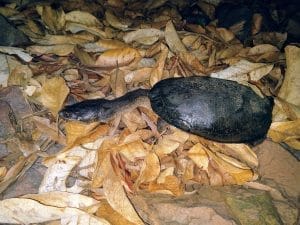Chelodina ipudinapi (Ipudinapi Snake-necked Turtle)
Home > Turtle Database > Chelodina ipudinapi (Ipudinapi Snake-necked Turtle)

Chelodina ipudinapi, recently described, is an intriguing species of freshwater turtle from the Chelodina group, known for its distinctive long neck. This turtle, primarily found in New Guinea, has generated interest due to its unique morphological and ecological traits.
Native To These Regions
Papua New GuineaNative Turtle Species Map – Find Turtles by Region
Scientific Classification
- Kingdom: Animalia
- Phylum: Chordata
- Class: Reptilia
- Order: Testudines
- Family: Chelidae
- Genus: Chelodina
- Species: Chelodina ipudinapi
Common Names
- Ipudinapi Snake-necked Turtle
- Aramia Snake-necked Turtle
This Hilarious Turtle Book Might Know Your Pet Better Than You Do
Let’s be real—most turtle care guides feel like reading a textbook written by a sleep-deprived zookeeper.
This one’s not that.
Told from the snarky point of view of a grumpy, judgmental turtle, 21 Turtle Truths You’ll Never Read in a Care Guide is packed with sarcasm, sass, and surprisingly useful insights.
And hey—you don’t have to commit to the whole thing just yet.
Grab 2 free truths from the ebook and get a taste of what your turtle really thinks about your setup, your food choices, and that weird plastic palm tree.
It’s funny, it’s honest, and if you’ve ever owned a turtle who glares at you like you’re the problem—you’ll feel seen.
Identification
- Description: This species features a long, snake-like neck, a highly streamlined shell, and a muted color palette of browns and greens that blend seamlessly with its aquatic environment.
- Sexual Dimorphism: Typically, males have longer, thicker tails and slightly concave plastrons, aiding in mating.
Check more turtles from the Chelodina genus
Native Origin and Distribution
- Geographical Range: Chelodina ipudinapi is found in the freshwater systems of southern New Guinea.
Preferred Habitat
- These turtles favor slow-moving rivers, swamps, and marshlands that offer abundant vegetation and hiding spots.
Behavior
- Feeding Habits: They are carnivorous, primarily preying on fish, crustaceans, and aquatic insects.
- Predators: Predation mainly comes from larger aquatic animals and birds when juveniles venture to the surface.
Reproduction
- Breeding Season: Breeding tends to occur during the rainy season when water levels are higher.
- Reproductive Method: Like other Chelodina species, it lays eggs in nests near water bodies, with the young hatching and immediately heading for water.
Conservation
- Extinction Status: Not yet assessed for the IUCN Red List but considered vulnerable due to limited distribution.
- Threats: Habitat destruction and water pollution are the primary threats.
- Conservation Measures: Local conservation initiatives aim to protect habitats and regulate water quality.
Economic Importance
- The species has minimal direct economic importance but contributes to the biodiversity of its native ecosystems, potentially supporting ecotourism.
Interesting Facts
- Chelodina ipudinapi’s neck can reach nearly the same length as its shell, a feature that is highly unusual even among long-necked turtles.
Research Studies
- For an in-depth study on Chelodina ipudinapi, you can refer to this research paper: A New Species of Chelodina (Testudines: Pleurodira: Chelidae) from Northern Australia

About Author
Muntaseer Rahman started keeping pet turtles back in 2013. He also owns the largest Turtle & Tortoise Facebook community in Bangladesh. These days he is mostly active on Facebook.














